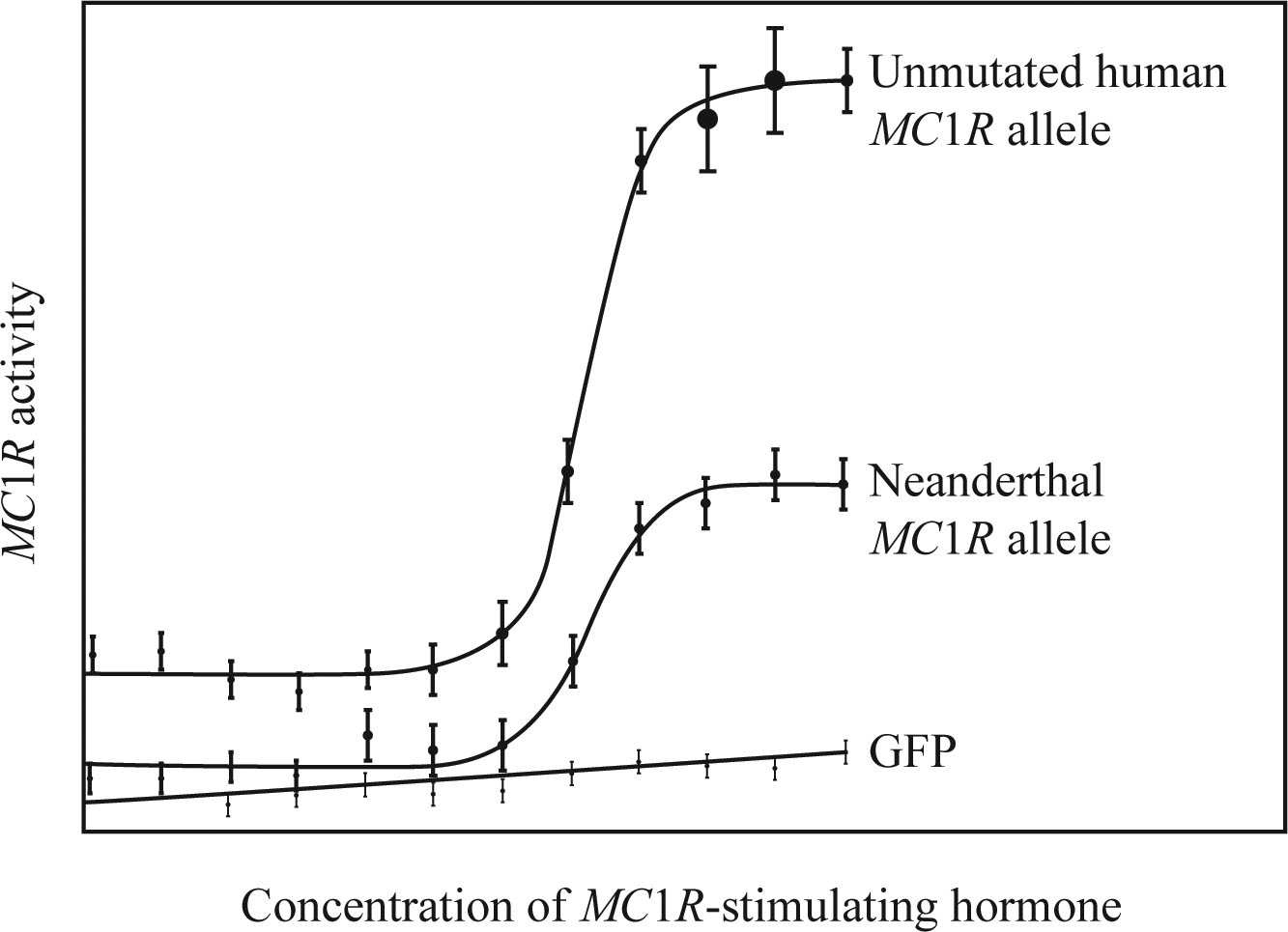
Concept explainers
Data Analysis Activities
Neanderthal Hair Color The MC1R gene regulates pigmentation in humans (Sections 13.5 and 14.2), so Loss-of-function mutations in this gene affect hair and skin color. A person with two mutated alleles for this gene makes more of the reddish melanin than the brownish melanin, resu.lti.ng in red hair and pale skin. DNA extracted from two Neanderthal fossils contains a mutated MC1R allele that has not yet been found in humans. To see how the Neanderthal mutation affects the function of the MC1R gene, Carles Lalueza-Fox and her team introduced the allele in to cultured monkey cells (FIGURE 26.12).

FIGURE 26.12 MC1Ractivity. Activity is shown in monkey cells transgenic for an unmutated MC1R gene, the Neanderthal MC1R allele, or the gene for green fluorescent protein (GFP). GFP is not related to MC1R.
How did MCR1 activity in monkey cells with the mutant allele differ from that in cells with the normal allele?
To explain: The way in which the MC1R activity in the monkey cells with the mutant allele differs from that in cells with the normal allele.
Introduction: Neanderthals are extinct hominins that are the closest relatives of Homo sapiens and habituated to the Middle East, Europe, and Asia. The pigmentation in humans is regulated by MC1R. The loss of function mutation in the MC1R gene, in turn, affects the skin and hair color. The homozygous mutation of the gene results in red hair and pale skin phenotypes.
Explanation of Solution
Scientist C and her team worked on MC1R mutated form that was present only in the Neanderthals. The team incorporated the allele from Neanderthal into cultured monkey cells.
Based on the results from the experiment, a graph was plotted with the concentration of the hormone that stimulates MC1R in the X-axis and the activity of MC1R in the Y-axis. Three scatter plots were plotted: one for green fluorescent protein (GFP), one for Neanderthal MC1R allele, and one for unmutated human MC1R allele. The activity of MC1R was very high in the transgenic monkey cells when compared to the normal allele.
The MC1R activity in the monkey cells with the mutant allele was much greater than the cells that had a normal allele for MC1R.
Want to see more full solutions like this?
Chapter 26 Solutions
Biology: The Unity and Diversity of Life (MindTap Course List)
Additional Science Textbook Solutions
Biological Science (6th Edition)
Laboratory Manual For Human Anatomy & Physiology
SEELEY'S ANATOMY+PHYSIOLOGY
Biology: Life on Earth with Physiology (11th Edition)
Chemistry: A Molecular Approach (4th Edition)
- When beta-lactamase was isolated from Staphylcoccus aureus and treated with a phosphorylating agent, only the active site, serine was phosphorylated. Additionally, the serine was found to constitute 0.35% (by weight) of this beta-lactamase enzyme. Using this, calculate the molecular weight of this enzyme and estimate the number of amino acids present in the polypeptide.arrow_forwardBased on your results from the Mannitol Salt Agar (MSA) media, which of your bacteria were mannitol fermenters and which were not mannitol fermenters?arrow_forwardhelp tutor pleasearrow_forward
- Q8. A researcher wants to study the effectiveness of a pill intended to reduce stomach heartburn in pregnant women. The researcher chooses randomly 400 women to participate in this experiment for 9 months of their pregnancy period. They all need to have the same diet. The researcher designs two groups of 200 participants: One group take the real medication intended to reduce heartburn, while the other group take placebo medication. In this study what are: Independent variable: Dependent variable: Control variable: Experimental group: " Control group: If the participants do not know who is consuming the real pills and who is consuming the sugar pills. This study is It happens that 40% of the participants do not find the treatment helpful and drop out after 6 months. The researcher throws out the data from subjects that drop out. What type of bias is there in this study? If the company who makes the medication funds this research, what type of bias might exist in this research work?arrow_forwardHow do I determine the inhertiance pattern from the pedigree diagram?arrow_forwardits an open book assignemntarrow_forward
- Describe two different gene regulation mechanisms involving methylationarrow_forwardWhat is behavioral adaptarrow_forward22. Which of the following mutant proteins is expected to have a dominant negative effect when over- expressed in normal cells? a. mutant PI3-kinase that lacks the SH2 domain but retains the kinase function b. mutant Grb2 protein that cannot bind to RTK c. mutant RTK that lacks the extracellular domain d. mutant PDK that has the PH domain but lost the kinase function e. all of the abovearrow_forward
 Biology: The Unity and Diversity of Life (MindTap...BiologyISBN:9781305073951Author:Cecie Starr, Ralph Taggart, Christine Evers, Lisa StarrPublisher:Cengage Learning
Biology: The Unity and Diversity of Life (MindTap...BiologyISBN:9781305073951Author:Cecie Starr, Ralph Taggart, Christine Evers, Lisa StarrPublisher:Cengage Learning Biology: The Unity and Diversity of Life (MindTap...BiologyISBN:9781337408332Author:Cecie Starr, Ralph Taggart, Christine Evers, Lisa StarrPublisher:Cengage Learning
Biology: The Unity and Diversity of Life (MindTap...BiologyISBN:9781337408332Author:Cecie Starr, Ralph Taggart, Christine Evers, Lisa StarrPublisher:Cengage Learning Human Heredity: Principles and Issues (MindTap Co...BiologyISBN:9781305251052Author:Michael CummingsPublisher:Cengage Learning
Human Heredity: Principles and Issues (MindTap Co...BiologyISBN:9781305251052Author:Michael CummingsPublisher:Cengage Learning Biology Today and Tomorrow without Physiology (Mi...BiologyISBN:9781305117396Author:Cecie Starr, Christine Evers, Lisa StarrPublisher:Cengage Learning
Biology Today and Tomorrow without Physiology (Mi...BiologyISBN:9781305117396Author:Cecie Starr, Christine Evers, Lisa StarrPublisher:Cengage Learning Biology: The Dynamic Science (MindTap Course List)BiologyISBN:9781305389892Author:Peter J. Russell, Paul E. Hertz, Beverly McMillanPublisher:Cengage Learning
Biology: The Dynamic Science (MindTap Course List)BiologyISBN:9781305389892Author:Peter J. Russell, Paul E. Hertz, Beverly McMillanPublisher:Cengage Learning Biology (MindTap Course List)BiologyISBN:9781337392938Author:Eldra Solomon, Charles Martin, Diana W. Martin, Linda R. BergPublisher:Cengage Learning
Biology (MindTap Course List)BiologyISBN:9781337392938Author:Eldra Solomon, Charles Martin, Diana W. Martin, Linda R. BergPublisher:Cengage Learning





